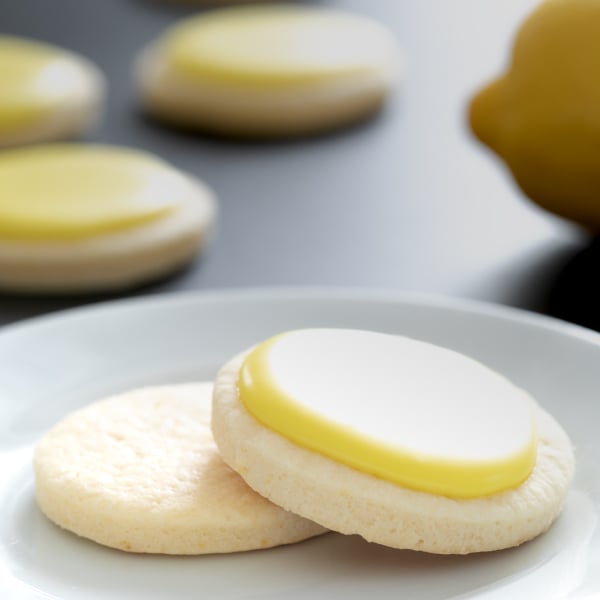

These soft, chewy cutout gluten free lemon sugar cookies are just like Lofthouse cookies, but with a simple lemon icing and just enough bright, citrus flavor.
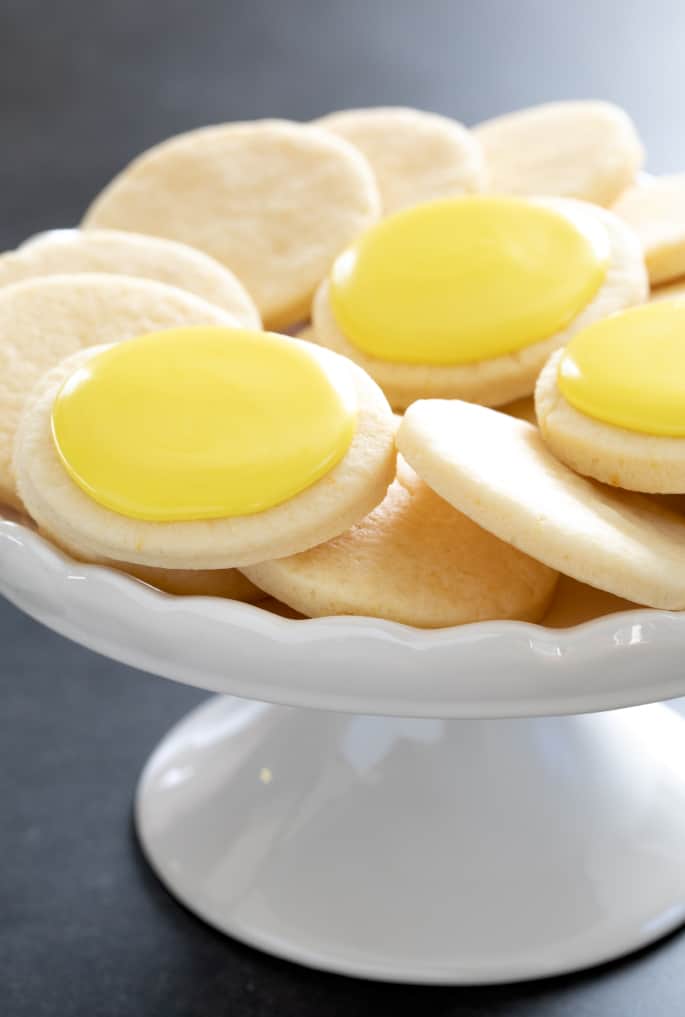
WANT TO SAVE THIS RECIPE?
Why we love these gluten free lemon sugar cookies
These lemon sugar cookies are soft, but not delicate, with the perfect lemon flavor. It's strong enough that no one will doubt that these are lemon cookies, but not enough to make you pucker and squint! ?
The simple yellow icing lends a nice touch and can be made with more lemon juice, or just water. If you tint the icing yellow, everyone will assume it tastes like lemon anyway!
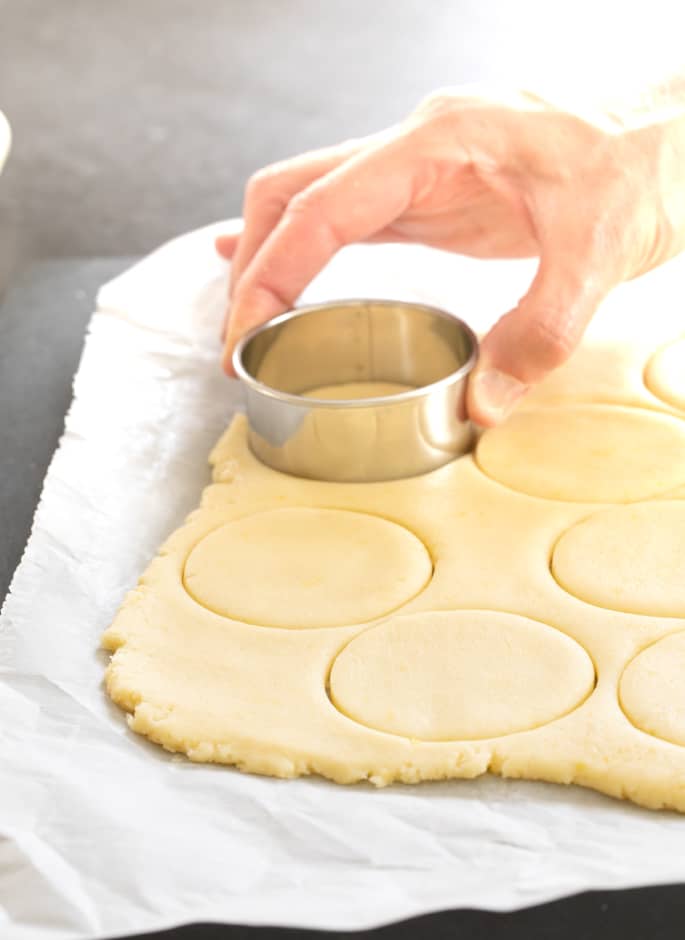
How to make these cutout lemon sugar cookies
This cookie dough is prepared in a single mixing bowl. Simply combine the dry ingredients (flour, cornstarch, baking powder, salt) with the sugar and zest, and whisk it to combine well. You'll want to make sure you break up any clumps of zest.
Then, add the softened butter, egg, vanilla, and lemon juice, and mix to combine. The dough will come together with the spoon, but you may have to knead in the last few bits of dry ingredients.
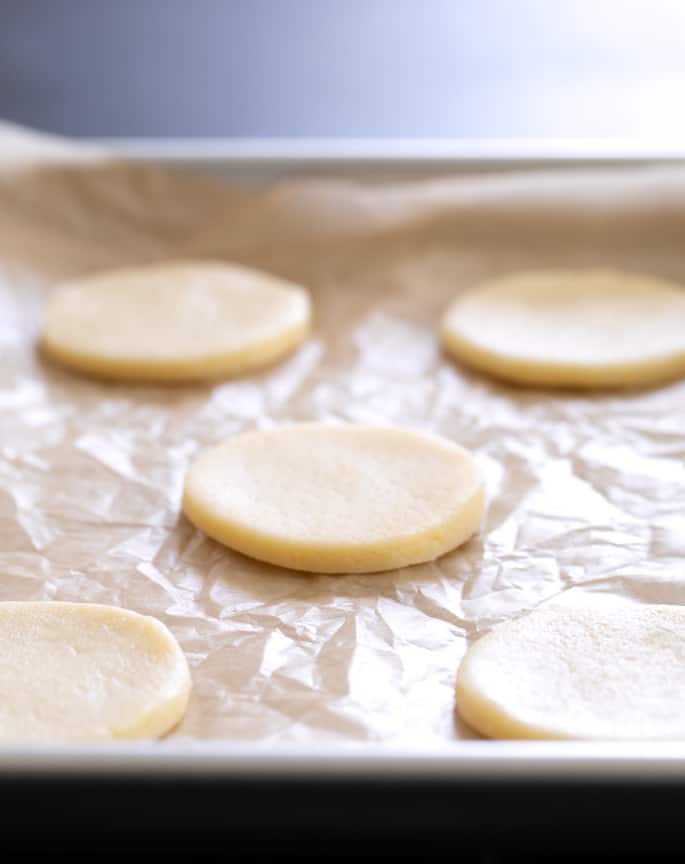
What should the cookie dough feel like?
The cookie dough that this recipe makes, like in our original recipe for Lofthouse-style gluten free sugar cookies, is very thick. It's not so stiff that it's difficult to roll out with a rolling pin, but it's thick enough that you will likely have to knead those last little bits of dry ingredients into the dough.
If any of your ingredient amounts are off at all, you'll know when you roll out the dough and cut shapes. The shapes will cut easily as they should but the edges of the dough won't be sharp and blunt.
If you find that's the case, all is not lost! Just add more all purpose gluten free flour by the half-teaspoonful and knead it into the dough until you reach the proper consistency. You won't ruin the dough by rolling it multiple times.
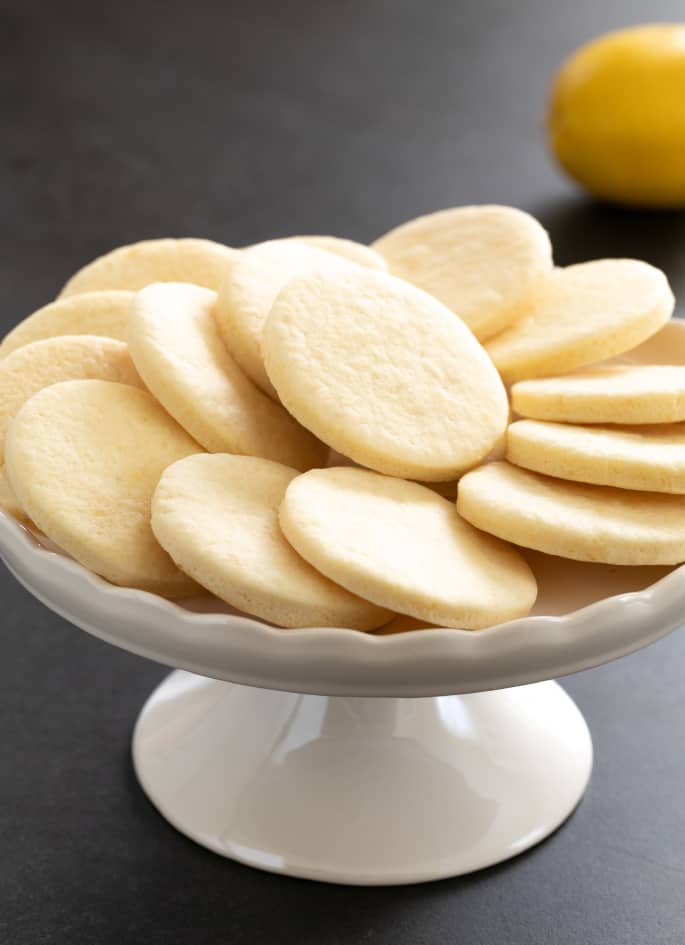
How to roll out cookie dough perfectly every time
You shouldn't need to flour the surface or flour the dough to roll it out into a rectangle about 1/3-inch thick. It should roll easily.
If the dough is sticking to your rolling pin as you roll, the dough needs a bit more flour to even it out. Just add a half to a full-teaspoon of all purpose gluten free flour to the dough, and knead it in. Then, try rolling it out again.
If you'd prefer, you can place the dough between two sheets of unbleached parchment paper and roll it out that way. The parchment paper has a tendency to wrinkle, though, which can wrinkle the cookie dough.
If you aren't sure if your dough is an even thickness everywhere, run the palms of your hands gently over the top of the dough. You'll feel any thicker spots, and you can go over them with the rolling pin.
Then, cut out shapes with a cookie cutter with sharp edges, and pull the surrounding dough away from the cutouts. Transfer the rounds to prepared baking sheets, then gather and reroll the dough. Repeat until you don't have enough dough for even one last cutout.
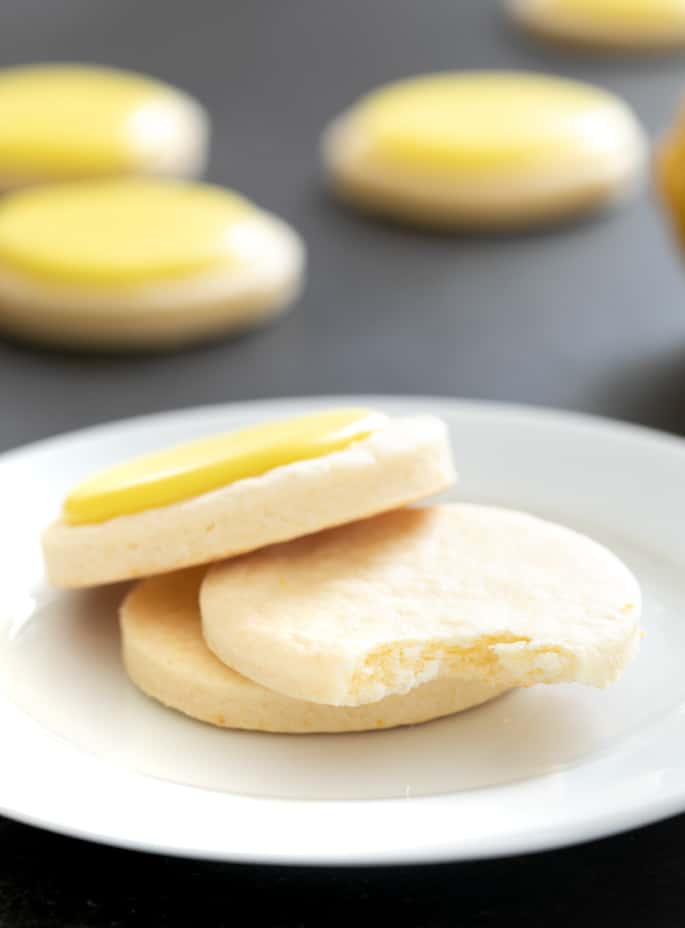
Fresh lemons are the key
Where I live in NY, fresh lemons are in peak season where I live from November through March. That hardly seems to matter though, as they're available in grocery stores year-round.
It might just be my imagination, but I feel like lemons are at their best in the summertime. And that's when I turn to recipes like these lemon sugar cookies and our gluten free lemon bars.
You might be tempted to buy those squeeze bottles of “fresh” lemon juice (how can it be fresh when you didn't squeeze it from a lemon yourself?), but I find that the juice is much more acidic. At the same time, the lemon flavor is less pronounced.
Fresh lemons will keep in the refrigerator for at least 2 weeks. And even if your fresh lemon isn't as bright and shiny as the day you bought it, squeeze it and you'll still likely get some good tasting lemon juice.
Can you prepare the lemon juice ahead of time?
Of course, lemon juice will have the most flavor and taste its best right after it's squeezed. But if you have lemons that are on their way out, don't waste them!
Using a Microplane or other fine grater, collect as much of the zest as you can (without including any of the bitter white pith). Then, juice the lemons, place the liquid in an ice cube tray, and freeze until ready to thaw and use for baking.
The zest can even be stored in the refrigerator or freezer for later use, too, but it's really best when used soon after it's been grated.
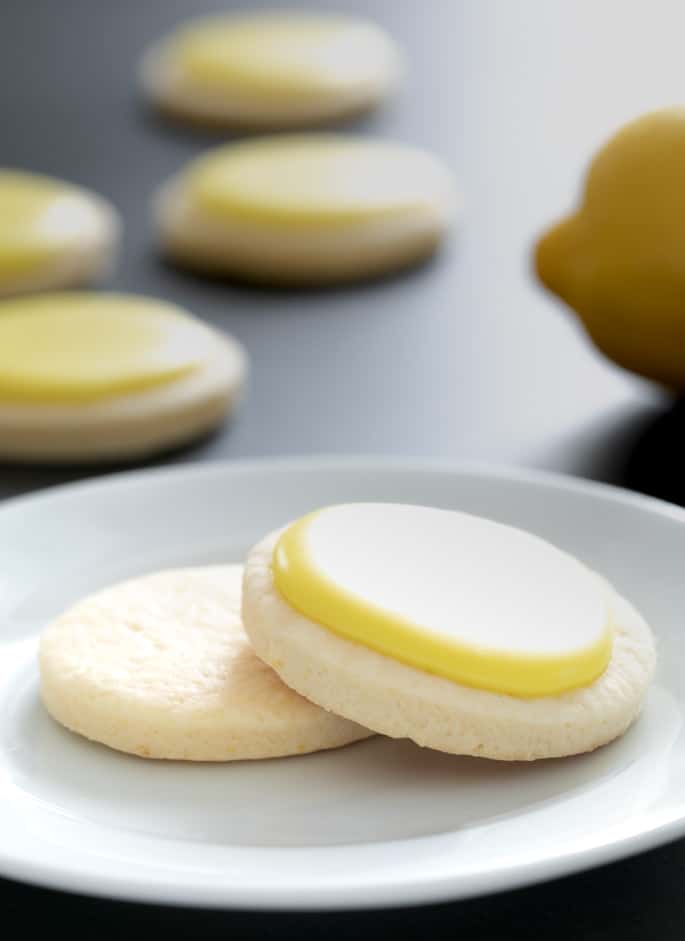
Ingredients and substitutions
Dairy-free: I think you should be able to replace the butter in the cookies with Melt brand vegan butter. The edges of the cookies aren’t quite as blunt and clean as they are when you make the recipe exactly as written, but the recipe should still work.
Otherwise, you can try using Spectrum brand nonhydrogenated vegetable shortening in place of butter. It doesn't have the moisture that butter has, though, so you might have to cut back on the lemon juice to make the cookie dough the proper consistency.
Egg-free: There is only one egg in the cookie recipe, so you should be able to replace it with a “chia egg” (1 tablespoon ground white chia seeds + 1 tablespoon lukewarm water, mixed and allowed to gel).
However, you can't avoid the flecks of color that inevitable in even ground white chia seeds, but that's a mild aesthetic issue.
Corn-free: You can replace the cornstarch with potato starch or arrowroot. Potato starch tends to clump even more than cornstarch, so be sure to break up any lumps.
If you are already using an all purpose gluten free flour blend that is high in starch, like Cup4Cup, replace the 1/4 cup of cornstarch called for in the recipe with an equal amount more of your all purpose gluten free flour blend.
Gluten Free Lemon Sugar Cookies
Ingredients
For the cookies
- 1 ⅓ cups (186 g) all purpose gluten free flour blend plus more as necessary (I used Better Batter; please click thru for full info on appropriate blends)
- ½ teaspoon xanthan gum (omit if your blend already contains it)
- ¼ cup (36 g) cornstarch
- ⅛ teaspoon kosher salt
- ¼ teaspoon baking powder
- ½ cup (100 g) granulated sugar
- 4 teaspoons lemon zest
- 4 tablespoons (56 g) unsalted butter at room temperature
- 1 (50 g (weighed out of shell)) egg at room temperature, lightly beaten
- ½ teaspoon pure vanilla extract
- 3 tablespoons freshly squeezed lemon juice
For the icing
- 1 cup (115 g) confectioners’ sugar
- 2 to 4 teaspoons freshly squeezed lemon juice or water
- Yellow gel food coloring (optional)
Instructions
- Preheat your oven to 325°F. Line rimmed baking sheets with parchment paper and set them aside.
- In a large bowl, place the flour, xanthan gum, cornstarch, salt, baking powder, sugar, and lemon zest, and whisk to combine well.
- Add the butter, egg, vanilla, and lemon juice, and mix until the cookie dough comes together. It should be smooth and thick. Add more flour by the half-teaspoonful if necessary to help the dough have the proper feel.
- Place the dough on a flat surface and roll with a rolling pin into a rectangle a bit less than 1/3-inch thick.
- Using a 2 1/2-inch round cookie cutter, cut out rounds of dough and place them about 1-inch apart on the prepared baking sheets. Gather and reroll any scraps, then cut out more shapes until you only have scraps too small to reroll.
- Place the baking sheet in the center of the preheated oven and bake for 10 to 12 minutes, or until the bottoms and edges of the cookies are firm and pale golden.
- Allow to cool on the baking sheets for about 5 minutes, then transfer to a wire rack to cool completely.
- When the cookies are nearly cool, make the icing. In a small bowl, place the confectioners’ sugar and 2 teaspoons of lemon juice or water, and mix well.
- Add more liquid by the half-teaspoon until you have a smooth but very thickly pourable glaze. Add the optional food coloring and mix until the color is uniform.
- Using a wide spoon or a small offset spatula, spread the glaze in an even layer on the top of each cookie.
- Set the cookies on a flat surface and allow the icing to set. To fully set, it may take up to 12 hours. It won’t set as hard as royal icing, though.
WANT TO SAVE THIS RECIPE?


Thanks for stopping by!
Hi, I’m Nicole. I create gluten free recipes that really work and taste as good as you remember. No more making separate meals when someone is GF, or buying packaged foods that aren’t good enough to justify the price. At Gluten Free on a Shoestring, “good, for gluten free” just isn’t good enough! Come visit my bio!
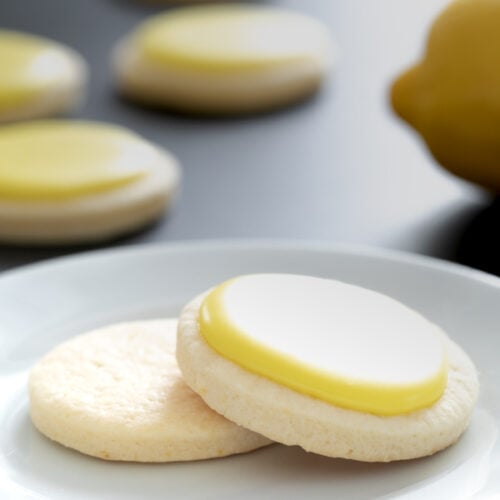

Lauren P. says
THANK YOU SO MUCH for the three substitutions that you offered– I need all three! It’s been a long time since I’ve been to your site after being demoralized following these additional allergy diagnoses. I’m such a lemon fanatic and have been craving cookies like there’s a cookie apocalypse coming. I hadn’t been able to find a recipe that worked with all of my new limitations in addition to the old ones. But you wafted the sweet scent of possibilities into my inbox, and I promise that tomorrow those lemons on my counter will have a majestic makeover. Thanks for continuing to be such an awesome creator!
Nicole Hunn says
I’m so so glad, Lauren, that things worked out. I totally get the idea of feeling demoralized after being even more restricted. I try to give as much information as I can so that you feel a sense of possibility. And it sounds like it worked! Thank you so much for letting me know.
LauraU says
So happy to have found these. I’m going to roll thicker and put a wee bit of strawberry /lemon filling inside too. I was asked to bring a dessert to a gathering. “Impress me with your gf skills”, said the chef. Gulp! I’ll let you know! ????
Nicole Hunn says
Good luck, Laura!
GF Mum says
We made these last night and everyone loved them. Just the right amount of lemon. And so easy to make!
Jan says
After reading all the comments and replies, I was about to ask if you can roll a bit thinner and then sandwich two cookies together with the lemon icing (a bit like melting moments). Would that work as well?
Nicole Hunn says
Hi, Jan, I actually have a recipe for meltaway cookies (here’s a link for the lemon ones, and I also have a vanilla version), but they’re not for rolling thin. You can definitely roll these lemon cookies thinner, but you’ll have to be really careful not to overbake them lest they become crispy. Hope that helps!
Rochelle D says
Luv anything lemon so I can’t wait to try this recipe! I like to make large batches of cookies and freeze them so I’ll have them on hand when I have my cravings :) I was wondering if you have made these and put them in the freezer (without the icing)? How are they when you thaw them?
Nicole Hunn says
Hi, Rochelle, I certainly have! They freeze amazingly well (without the icing, as you mentioned), and are good as new after defrosting. They never even freeze fully solid so you barely have to defrost, in fact.
Chris says
In the recipe you say 1/2 cup of granulated sugar “plus more for dusting” but nowhere do you dust anything with granulated sugar. What am I missing?
Nicole Hunn says
So sorry, Chris. That’s from the recipe as it was originally written, in which I called for dusting the raw dough with sugar before baking. Fixing now!
Hannah Stratton says
Hi Nicole,
Would these work with Cup4Cup, I’m assuming don’t add the cornstarch and add in more flour since it’s got a higher starch content than BetterBatter?
Nicole Hunn says
They sure would, Hannah! I actually mention that in the “Ingredients and substitutions” section. :)
Anneke says
Hello Nicole! Last time we talked, I was cranky. And depressed. But not about lemons — love lemons! I am nervous about these, cause you know how I am about cookies, but I think I can do these eventually. Not today, though, today is more tortillas (feeling very confident!) and graham crackers, actually. Cause my daughter is making s’mores bars for Friday’s cross country meet. Yum. Anyway, I do have that thick mane of great morning hair — so sorry, hope we can still be friends! But I also love my bed and my sleep, I bet just about as much as you do! So I think it will all work out! Thanks! Anneke
Nicole says
Hi, Anneke,
I know you can do these cookies. But I’m glad you’re sticking with the tortillas. I’m sure you’ll do great! S’mores bars sound great. It is so important to have a Graham cracker recipe in your back pocket, you know? I knew you had beautiful morning hair! Of course we’re still friends. A little envy keeps the friendship fresh and alive. :)
xoxo
Nicole
Michelle says
Oh my… these look to be the prefect dessert for a GF family BBQ coming up. YUM!
PS – I only pretend to be a morning person…. my kids know not to even talk to me before I’ve had my tea! :-)
Nicole says
Hi, Michelle,
Yes! These are the perfect sweet ending for a BBQ. Roll them out a tiny bit thicker and they’ll make really sturdy ice cream sandwiches!
One reason I get up as early as I do is so that I’m up before the children. Please don’t tell them. :)
xoxo Nicole